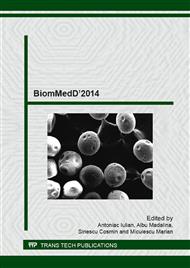p.183
p.191
p.197
p.205
p.210
p.216
p.222
p.228
p.233
Alternative Technologies for Obtaining the Metal-Ceramic Dental Prostheses Imposed by some Clinical Situations – A Case Series
Abstract:
In the contemporary dentistry the highly esthetic prosthetic restorations are readily achievable knowing the patient's expectations, communicating effectively with the dental technician and selecting appropriate materials and technologies. One of the important factors that influence the ceramic resistance in the metal-ceramic restorations is the design of the framework. A design of the framework that provides support for cusps may therefore be advantageous in preventing the fracture of the plating ceramics. The outer geometry of the metal-ceramic restorations is strongly defined by anatomical and physiological circumstances. Although a change in the framework design does not necessarily affect the external form of the restoration, a thicker frame automatically implies a thinner layer of veneering and vice versa.In this study we present a series of clinical cases in which we have used different techniques for modeling the wax patterns of the future metal structure according to several clinical features. There are presented techniques for obtaining the layouts for the metallic structures of partial or total esthetic metal-ceramic restorations, dental supported or implant supported, classic techniques and innovative techniques that allow previewing the final aspect of restoration and the transfer of clinical data for a highly functional prosthesis.The wax patterns are exact copies of future prosthetic parts, so should be done with great care. The ergonomics had made place also at this level currently existing a multitude of techniques and materials that facilitate the dental technician’s work.
Info:
Periodical:
Pages:
210-215
Citation:
Online since:
March 2015
Authors:
Keywords:
Price:
Сopyright:
© 2015 Trans Tech Publications Ltd. All Rights Reserved
Share:
Citation:


